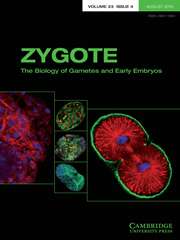No CrossRef data available.
Article contents
Combination of FSH and testosterone could enhance activation of primordial follicles and growth of activated follicles in 1-day-old mice ovaries in vitro cultured for 12 days
Published online by Cambridge University Press: 23 December 2024
Abstract
Treatment with follicle-stimulating hormone (FSH) and testosterone (T2) and their combination have been observed to be influential on ovarian follicles of 1-day-old mice ovaries cultured for 8 days. Given that extension of the culture period could positively impact the development of follicles in cultured ovaries, the present study was conducted to evaluate the main and interaction effects of FSH by T2 on the development of ovarian follicles in 1-day-old mice ovaries cultured for 12 days. One-day-old mice ovaries were initially cultured with base medium for 4 days; thereafter, different hormonal treatments were added to the culture media, and the culture was continued for 8 additional days until day 12. Ovaries were collected for histological and molecular assessments on day 12. The greatest activation of primordial follicles and progression of activated follicles to the preantral stage was detected in ovaries treated with the combination of FSH and T2 (P < 0.05). This positive effect on the morphology of ovarian follicles was accompanied by upregulation of Pi3k, Gdf9, Bmp15, Cx37 and Fshr in the ovaries cultured with the combination of FSH and T2 (P < 0.05). Nonetheless, treatment with FSH and T2 led to a diminished proportion of intact follicles (P < 0.05), even though Bax/Bcl2 gene expression ratio, as an apoptotic index, was less in hormone-treated ovaries (P < 0.05). In conclusion, the combination of FSH and T2 could improve the activation of primordial follicles and the growth of activated follicles towards the preantral stage. This positive effect of FSH plus T2 appeared to be at least partly mediated through the upregulation of Pi3k and oocyte-derived growth factors including Gdf9 and Bmp15.
Keywords
- Type
- Research Article
- Information
- Copyright
- © The Author(s), 2024. Published by Cambridge University Press
Footnotes
These authors equally contributed to the present study.



